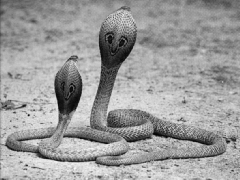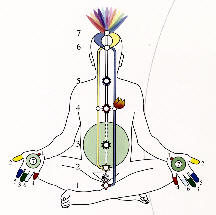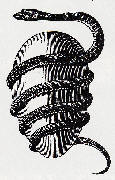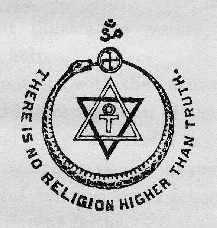Serpent Power
| By: Carl Teichrib; ©2002 |
| In the Bible we have a serpent involved in the temptation of Eve. Here the serpent is the embodiment of evil. While snakes in and of themselves are not evil (despite their bad press), the same cannot be said for the serpent symbol within occult circles. Carl Teichrib gives us numerous examples of how and where serpents appear as the antithesis of God’s wisdom, power and authority. |

- Symbols possess an esoteric language, a secret code, which the [occult] student must decipher and whose meaning he or she must unlock. —Erwin W. E. Watermeyer, “Symbols: The Tools of Initiation,” Rosicrucian Digest, March 1985.
- …symbols form a visual shorthand for ideas—and yet their functions and meanings extend to something much more than that. — Jack Tresidder, Dictionary of Symbols, p. 6.
Throughout the ages, certain symbols have been employed to communicate hidden mystical messages. For practitioners of the occult, these symbols are tools specifically used in conjuring and wielding supernatural powers, and in communicating their secret doctrines. And while these symbols are often many centuries old, their meanings have remained essentially the same. In fact, as the public extension of ancient occult teachings, the New Age movement has placed mystical symbolism squarely in the face of our modern culture. What makes this especially disturbing is that while the “marks” of occultism can be found throughout society, we no longer recognize their spiritual implications. Conversely, just because the average person doesn’t know the meaning of occult symbols, it in no way negates their significance. Manly P. Hall, one of the most influential occultists of the last century, wrote this of symbols, “They are centers of a mighty force, figures pregnant with an awful power…” (Lectures on Ancient Philosophy, p. 356).
Contents
Serpent Power:
- “Now the serpent was more cunning than any beast of the field…” — Genesis 3:1.
In Genesis chapter three, we find a creature—a serpent—trying to seduce Eve into sinning against God. As Christians, we recognize this event as part of the fall of man. Viewed in this light, the serpent is seen as a symbol of the embodiment of evil—Satan incarnate within the physical body of one of God’s creatures. While serpents in and of themselves are not evil (you may not like snakes, but they are part of God’s creation), Lucifer’s deceptive use of the creature was an act of wickedness. Hence, within Christianity the serpent has been associated with evil. But not all religions view the serpent this way.
In his book, The Sign of the Serpent, Mark Balfour relates how pervasive serpent symbols are within India and the Hindu religion,
- Any observant traveler who moves from the snow-tipped Himalayas in the North to the sun-soaked sands of Cape Comorin at India’s southern tip, will encounter — particularly in the rural areas and at sacred centres of pilgrimage wherever Siva, God of both Divine Wisdom and regeneration, is the presiding Deity—the serpent motif sculptured within shrines, impressed on myriads of stone implants in the ground and depicted in art.

Balfour explains that this preoccupation with serpent imagery is more than just decorative, “The symbol is representative of the essential fabric upon which the higher Indian mentality is woven.” This “higher…mentality” views the cobra serpent as a symbol of the “creative process and the dynamic forces or energies operative throughout nature.” As stated by Balfour, “The Serpent throughout time has existed as a symbol of the energizing creative force of the one supreme universal Spirit.”
Balfour elaborates on this Hindu belief,
- In Hinduism, the Cosmic Serpent—Ananta Sesha—symbolic of timeless eternity, carries the world on his 1000-fold [Cobra] hood…As the creative impulse stirs within the great Serpent in the Sky—when passive idea becomes active thought—the forces of attraction and repulsion come into play as ‘spirit’ begins its involution into “matter.”

Moreover, Kundalini yoga—a yoga discipline within Hinduism —teaches that vast amounts of latent energy lies at the base of the human spine; “like a coiled serpent, ready to spring” (Harper’s Dictionary of Hinduism, p. 156). Through strenuous yoga techniques, this serpent-coiled spiritual energy is awakened and rises through seven “chakras”—or power centers—within the human body. This spiritual energy is known as the “serpent force,” and is considered to be “a concentrated field of intelligent cosmic, invisible energy absolutely vital to life; beginning in the base of the spine as a man or a woman begins to evolve in their first incarnation…” (The Donning International Encyclopedic Psychic Dictionary, p. 343).

Hinduism isn’t the only religion that holds an exulted view of the serpent. Celtic religion places the snake in the “composite role of fertility, healing and underworld symbol” (Dictionary of Celtic Myth and Legend, p. 194). Within the Egyptian mysteries, the serpent was associated with “the elemental forces that were in play before the creation of the world” (Gods of Ancient Egypt, p. 182). Serpents in China were spiritually linked with water and the earth, and in Scandinavian myth a world serpent protected man from cosmic “forces of chaos.”

One occult organization that uses the symbol of the serpent is the Theosophical Society. This group, which arose from the teachings of H.P. Blavatsky, has as part of its logo a serpent eating its own tail. This image, according to the occult teachings of Blavatsky, represents “self-generation and evolution through its own creative power”—it is, esoterically speaking, a symbol of wisdom and intellectual freedom; man is his own creator and guides his own destiny.
This concept of “serpent wisdom” is prevalent throughout occult doctrines. Hence, the serpent of Genesis is recognized within the occult as beneficial to humanity—a good and beautiful being. Instead of Lucifer deceiving Eve and causing the downfall of mankind, Lucifer is viewed as liberating humanity from the shackles of ignorance imposed by an “unjust and vindictive” God. Man—freed by Lucifer—no longer has to bow in service to God. Instead, man can pursue his own interests and aspire to his own divinity.
Contrast this to Proverbs 3:5-7, “Trust in the LORD with all your heart, and lean not on your own understanding; in all your ways acknowledge Him, and He shall direct your paths. Do not be wise in your own eyes; fear the LORD and depart from evil.” Also, “The fear of the LORD is the beginning of knowledge…” (Prov. 1:7). And, “There is a way which seems right to a man, but its end is the way of death” (Prov. 14:12).
Consider also the words of Jesus Christ, “I am the way, the truth, and the life. No one comes to the Father except through me” (John 14:6).
Serpent worship, occult doctrines, and the deliberate distortion of the Genesis account; yes, Satan has been working hard to ensure that mankind would turn away from the true and living God and embrace the lie told to Eve—“You will not surely die…eat of it…your eyes will be opened…you will be like God.”
(Carl Teichrib is a Canadian based researcher and writer on globalization and the occult. His work has been used by such authors as Gary Kah and Berit Kjos, among others. Carl may be reached by emailing: [email protected].)








[…] REDIRECT Serpent Power […]
[…] Serpent Power By: Carl Teichrib […]